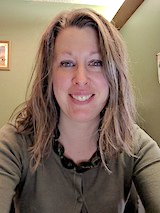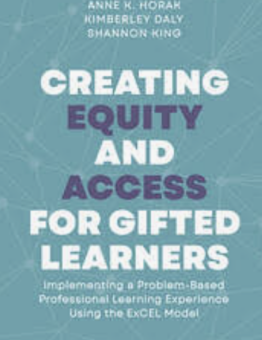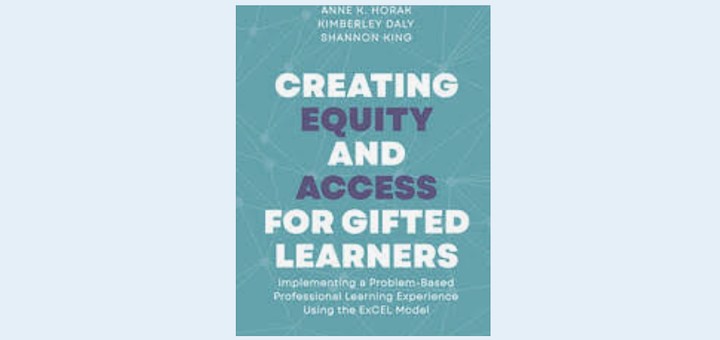Creating Equity and Access for Gifted Learners: Implementing a Problem-Based Professional Learning Experience Using the ExCEL Model
By Anne K. Horak, Kimberley Daly and Shannon King
(Routledge/Prufrock Press, 2025 – Learn more)
Reviewed by Kim Rensch

 The world of gifted education has not been immune to the racial reckoning taking place in our country these past few years. While some school districts eliminate entire gifted education programs in the name of equity, others double down on their identification efforts with the goal of casting the widest nets possible to identify students traditionally relegated to the margins.
The world of gifted education has not been immune to the racial reckoning taking place in our country these past few years. While some school districts eliminate entire gifted education programs in the name of equity, others double down on their identification efforts with the goal of casting the widest nets possible to identify students traditionally relegated to the margins.
There is a growing body of literature dedicated to identifying and serving students traditionally overlooked for gifted and talented programs. A recent addition to this professional library is the book Creating Equity and Access for Gifted Learners: Implementing a Problem-Based Professional Learning Experience Using the ExCEL Model by Anne K. Horak, Kimberley Daly, and Shannon King. The authors explicitly state in their preface that this book is for teachers of gifted students and general education students, as well as gifted education coordinators and instructional coaches.

 I picked up this book as the leader of a gifted education team on a journey to expand our understanding of equity in gifted education. I won’t bury the lede here: I am struggling with how to review this book.
I picked up this book as the leader of a gifted education team on a journey to expand our understanding of equity in gifted education. I won’t bury the lede here: I am struggling with how to review this book.
On the one hand, the material is compelling, written by practitioners with a clear passion for supporting the needs of gifted children and their teachers. The focus of the book is worthy of a reader’s time: it’s the ExCEL Model, a problem-based learning model that engages all learners and serves as both assessment and instructional tool. (Problem-based learning is a type of inquiry-based learning.)
Because inquiry-based learning models such as problem-based learning have grown in popularity over the past decade or two, there is no shortage of books about the topic. Much of this book is about the professional learning needed to help teachers implement the ExCEL Model of problem-based learning, making it a more fitting read for an audience of coordinators or administrators who wish to lead teachers in adopting a problem-based learning model.
The delivery of information sometimes left me a bit frustrated. My overall assessment is that the idea of using problem-based learning practices is important enough to dedicate some time to reading this book, but readers should know going in that the book will not be your one-stop shop for implementing the problem-based learning model in your school. Instead, consider it an introduction to the topic and a list of resources for further reading.
The Reading Experience
Creating Equity and Access was written by three educators whose paths crossed at pivotal moments in their careers, propelling them on a journey toward implementing and then leading professional learning experiences around the topic of problem-based learning. Reading about their perspectives and experiences was interesting and engaging.
Each author wrote two or three of the seven chapters and closing section of the book, which provided a unique perspective on the ExCEL Model while also contributing to a feeling of…something I am unable to put my finger on. Not quite disconnectedness. Maybe incompleteness is closer to what I am feeling.
To illustrate what I mean, consider this very last sentence of chapter two: “This last activity [problem debrief] allows students to make connections between the unit itself and the world around them” (31). The question I wrote in the margin was simply, “How?” I would have valued this accomplished educator’s perspective on how running a problem debrief would lead a student to make connections between learning and the world outside of school.
I also would have valued more information about how the authors have used problem-based learning as an opportunity to identify students for gifted programming. Finding non-traditional ways of identifying gifted learners is key to increasing access for underserved student populations. Should the authors decide to write a follow-up book, this topic should take top priority.
Where This Book Fell Short
I went into reading this book expecting to gain a clear vision of what the ExCEL model is and how it will create equity for students in gifted programs. I was looking forward to reading about classrooms that use this model. What is more helpful than stories from the frontlines from actual teachers working with actual students? What is more inspirational than student testimonials stating how much they learned and grew during a unit of learning?
I’m afraid that the book comes up just short of sparking innovation and inspiration. There were some glimmers of hope where the authors came close to igniting a spark. Chapter three, “The Case for Using Problem-Based Learning,” spent a page explaining how PBLs give students “an even playing field” because students engaged in PBLs “will have questions because there are gaps” (42). But if the second word of a book’s title is “Equity,” I was expecting more about equity than just a paragraph or page here and there.
Recommendations for Readers
As I read, I kept track of the questions popping up in my mind. It was not until chapter 7 that I felt many of these questions percolating in my brain were answered, and there are still plenty of questions left over to investigate. My best recommendation to a reader is to keep an ongoing list of questions with some space to write answers as they come. Readers might wish to read chapters out of order, starting with the introduction and perhaps jumping forward to chapter 7 before returning to chapter 1.
Each chapter has a resource section with journal articles and websites for deeper learning. Should a reader want to dive deeper, however, note that many of the resources need to be purchased, unless a school district has access to the journals in which they are published. Readers who are serious about implementing problem-based learning should consider making room in the budget for purchasing these journal articles.
A Final Thought on This Book
The one major benefit of reading this book was to help me frame some questions regarding problem-based learning for future investigation. Readers who are administrators or gifted and talented coordinators should include the book as one part of a larger body of resources to support the implementation of problem-based learning.
Kim Rensch is a National Board Certified Teacher and former middle school language arts teacher working as the lead facilitator of the Gifted Services team for Fargo Public Schools in North Dakota. She is a board member for the North Dakota Association for Gifted Children. When she is not advocating for gifted children, Kim can be found at church, digging around the garden, or on walking trails with her husband and dogs.









